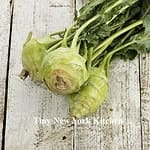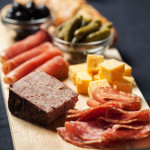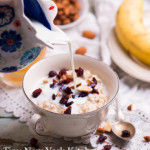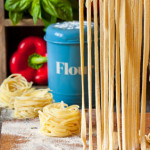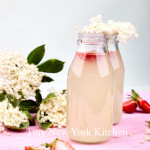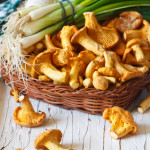Kohlrabi (pronounced cole-rah-bee) is in season now. This funny looking vegetable is so versatile and delicious. Try it raw in a crunchy slaw, blended into a velvety soup, or in place of rice for a low-carb side.
Though it looks like a root, kohlrabi is actually a bulb that grows above ground. It’s in the same family as cabbage, kale, Brussels sprouts, and cauliflower.
When eaten raw, kohlrabi is crunchy and mildly peppery, like radishes. When cooked, it becomes slightly tender and sweeter (similar to turnips and parsnips). The skin, while colorful, is slightly tough and won’t soften when cooked. Go ahead and peel first.
You’ll find both green and purple varieties though they taste the same. Look for firm, solid bulbs. Refrigerate unpeeled bulbs in your crisper drawer for about 2 weeks.
If leaves are attached, remove and reserve for other recipes. Cook them as you would kale. Cut a thin slice off the bottom so the bulb sits flat. Peel off the tough outer skin with a vegetable peeler. Slice into quarters, lengthwise, then cut out the core from each piece. Dice, slice, or shave per recipe instructions. Roast kohlrabi to bring out its naturally sweet and nutty flavor.
Only 37 calories per 1 cup of raw diced kohlrabi. 472 mg potassium per cup of diced kohlrabi, or as much as a medium banana. Potassium is essential for keeping your heart and nervous system working in top condition.
“Work With What You Got!”
©Tiny New York Kitchen © 2020 All Rights Reserved
A Charcuterie Board makes entertaining super easy. Whether you call it a charcuterie plate or a charcuterie board, it’s easy to make when you begin with quality smoked, cured, and cooked meats. The perfect charcuterie board will contain at least 3 to 5 types of charcuterie representing different styles and textures, an assortment of cheese, plus something acidic, like pickles and olives, and something sweet like fruit chutney to complement the flavors. Nuts, fresh and dried fruits, bread, and crackers also make wonderful accompaniments.
Start with a wooden board, plate, platter, or piece of slate as the base.
Choose at least 3 to 5 charcuterie items that represent various styles and textures: smoked and meaty, dry-cured and firm, cooked and creamy. Allow two ounces per person, and slice your charcuterie into easily manageable, bite-sized pieces.
Spread the pieces out on the board, leaving space between them for accompaniments.
Add mustard, cornichons, olives, or chutney, so the acidity can balance the fat in the charcuterie.
Fresh fruits like grapes, figs, sliced pears, and apples, and any dried fruits like raisins, currants, apricots, cherries, and pears will round out the board, and add color. Use the fruits as palate cleansers between bites of charcuterie.
Place sliced bread, or various types of crackers, around the edges of the board, or tuck them between sections of charcuterie.
Cheese is a welcome addition to a charcuterie board. Choose 2 to 3 types of different textures to complement the spread.
Add truffle butter, which is especially tasty on a slice of bread with dry-cured meats like saucisson sec.
A hearty red wine makes a good accompaniment, such as Côtes-du-Rhône, Gigondas or Madiran.
Types Of Charcuterie To Consider:
Prosciutto: Probably the most recognizable pork offering on the list. Each region of Italy has its own signature recipe and flavor profile, but the most common are from Parma, Tuscany, and San Daniele. Culatello is a boneless cousin of prosciutto with a higher meat-to-fat ration. If you’d like to avoid the fat, Spanish lomo and Italian lonzaare alternatives made with pork loin.
Soppressata: We like to think of soppressata as the adult pepperoni. This salumi is generally made from dry-cured, coarse ground pork with red pepper flakes from Southern Italy, though regional variations do exist.
Finocchiona: Packed with fennel seeds, this skinny Italian salami was first created during the Renaissance. If you’re not a fan of anise, try French saucisson sec, made with garlic and pepper.
Chicken Liver Mousse: This creamy, butter spread is a nice introduction pâté for those who are new to offal.
Pork Rillette: If you love pulled pork then this is for you. This rillette is slow cooked with spices, cut up, often pounded into a paste and topped off with rendered fat.
Speck: This lightly smoked prosciutto comes from Northern Italy. Also, worth getting is guanciale, cut from the jowl, or a spice-cured fatback called lardo.
Chorizo Picante: A Spanish pork salami, chorizo picante is spiced with hot paprika, not to be confused with the fresh chorizo sausages of Latin America.
Coppa: Short for capocollo, coppa is an Italian and Corsican dry-cured pork neck and shoulder salume (capo is Italian for head, while collo means neck). A spicy version is also available.
Duck Rillette: In this rillette, duck leg confit is shredded before being mixed with spices and Armagnac. It’s then crowned with duck fat, which is more delectable and slightly lower in saturated fats than pork.
Mousse du Périgord: A signature creation of Les Trois Petits Cochons, a famed charcuterie formed in New York City’s Greenwich Village, this blend of chicken and turkey livers is infused with herbs and bits of black truffle. Expect a bite that’s silky and smooth, with a top layer of aspic, a meat jelly.
Jamón Ibérico de Bellota: This is where jamon reaches its peak. It’s a Spanish ham where the pigs are allowed to graze acorns and herbs freely, which gives the meat a very unique aroma. A more affordable version is jamón serrano. For a woodsy addition, Bauernschinken is a similar option that’s smoked with juniper.
Bresaola: An air-dried beef round from Northern Italy’s Lombardy region.
Black Truffle Salami: Creminelli offers a tartufo salami that’s delicious. It’s embedded with summer truffles whose flavors and aroma integrate beautifully with the pork.
Rabbit Rillette: Versions of this rillette can be perfumed with juniper, mace and/or thyme. Rabbits aren’t as fatty as other animals, so these are often topped with duck fat.
Pâté de Campagne: Country pâté can be tough for some people because of its visible parts of offal and fat. Trust in a high-quality pâté that showcases beautiful chunks of ham. For an impressive upgrade, try pâté en croûte, a rustic loaf of pâté wrapped in pastry.
Tips For Serving:
Charcuterie can be enjoyed as an appetizer or a meal. If you want prosciutto for breakfast, go for it. For entertaining, charcuterie is a popular option because it can be put together ahead of time and covered with plastic wrap.
Remove all inedible material like twine, cloth, and tough salami casing before slicing.
Cubes are fine for cheese and cold cuts, but chunky charcuterie might be hard to bite or deliver too much salt per portion. Salted cured meats are best sliced thin and served immediately.
When you place charcuterie, drape each slice like you just shaved it yourself. Not only does it look attractive, it keeps each piece separated so that guests won’t struggle to peel them apart.
Choose a flat board or platter so everything can get picked up with tongs or a fork. It’s especially important if anything needs to be sliced, like a loaf of pâté.
Lipped, round serving trays are great if there are jars, small bowls, or ramekins that may be prone to slipping. To prevent small containers from sliding, wet a small cocktail napkin and fold it so it is hidden beneath the container.
Eat sliced meats with your hands, forks, or toothpicks. Don’t forget a knife for the pâté and rillettes.
Have fun with thin sliced meats by wrapping them around melon, asparagus, batons of cheese or grissini.
Since charcuterie tends to be in the red-brown range of the color spectrum, lay down a bed of sturdy greens like arugula as a base. In addition to being visually impressive, it makes cleaning much easier.
Invite cultured butter and cheese to the party. Let butter soften to room temperature so it’s easy to spread. Cheese from the same regions as your meats will complement each other nicely.
“Work With What You Got!”
©Tiny New York Kitchen © 2019 All Rights Reserved
Some people are natural bakers and some people learn as they go. I’m guessing that most people are the “learn as you go” types. Here are some little things that, are not giant revelations, but are useful tips to help you through your holiday baking.
Unwrap Butter Before Bringing To Room Temperature
Many recipes call for softened butter and if you’re using it, here’s a trick. Instructions for softening butter usually directs one to leave the butter on the counter until it reaches room temperature. It’s much better to unwrap the butter straight from the refrigerator and let it soften in the mixing bowl. When butter is cold, it lifts cleanly off the wrapper as opposed to much of it sticking to the paper and the mess it makes.
Use Butter Paper To Grease Pans
If you don’t unwrap your butter when cold and you have butter-globbed butter wrappers, use them to grease pans.
Use A Large Slotted Spoon To Separate Eggs
For separating eggs, break the whole egg into a small-size bowl. Grab the yolk with a metal slotted spoon. Use the wall of the bowl to help and let the white slink off the edge of the spoon, jiggling if the white is stubborn. The white doesn’t actually go through the wholes of the spoon, but the holes somehow seem to facilitate their departure. Do one at a time and transfer each one after so as not to taint the batch should a yolk break. If you are using just the whites and don’t need the yolks right away, stick them in the freezer for later use.
Use The Right Kind Of Measuring Cup
Use spouted cups for the measuring of wet ingredients. Use the scoop/cup type for dry ingredients. It’s hard to get an accurate amount of flour or sugar in a big glass measuring cup, and it’s hard not to spill oil or water when it’s filled to the brim in a scoop measuring cup. For wet ingredients, get to the eye level with the quantity marks and make sure they are even. For dry ingredients, spoon ingredients into the cup and then level it off with a knife.
Better Yet, Use A Scale
Unlike the rest of the world, American recipes use cups for measuring. Baking can be an exact science and as long as the recipe includes weights the scale is the most accurate way to measure.
Don’t Measure Over The Bowl
If you measure your ingredients over the bowl you just may get more in the bowl than you intended. Measure to the side of the bowl, even if it means having to wipe up a few grains of salt from the counter.
Know Your Oven’s Moods
Each oven heats differently. Ovens have hot and cool spots, which might explain uneven baking. Get into the habit of moving shelves around (middle rack is a good bet) and setting a timer to rotate pans halfway through baking. Test your oven by turning your oven to 350 F degrees, line the racks with slices of white bread and cook until they start to toast; remove them and analyze the results for a pattern. Are they even? Are the ones from the back darker than the rest?
Use An Oven Thermometer
Your oven dial may not be giving you an accurate read. The best way to avoid this is by purchasing an oven thermometer that sits inside the oven. Many bakers do this and having the ability to monitor the temperature in real-time allows you to adjust as needed.
Candy Thermometers
All candy thermometers are not created equally. Here’s how to calibrate your candy thermometer: Put the candy thermometer in a pot of water and bring it to a rolling boil, with constant and vigorous bubbles. The boiling point for water is 212 F (100 C), which is what your thermometer should read (if you are at sea level). You can leave it in there for a few minutes to make sure the reading is accurate.
Dark And Light Pans Are Not Perfectly Interchangeable
Are your cookies always overdone on the bottom? Are your roasted vegetables not getting browned enough? This one makes perfect sense. Dark pans absorb heat, light pans reflect it. Use light pans for cookies and cakes that don’t want a brown crust. Use dark pans for roasting vegetables, making pizza, or baking anything in which you want more of a crust.
Swapping Pan Sizes And Shapes
You might now want to use the pan that the recipe calls for. Pick up a copy of, Joy of Baking, and use the Baking Pan Sizes page. It has a list of every pan and its capacity, so that you can switch things around and swap pans with compatible capacities or adjust if needed.
Wear An Apron
Your apron will take a beating, but it will save your clothes!
“Work With What You Got!”
©Tiny New York Kitchen © 2019 All Rights Reserved
The fruit that is available in the autumn isn’t nearly as abundant as the fruit that’s available in the summer, but there are actually some delicious seasonal autumn fruits that you can look forward to eating. Delicious, tasty, and healthy seasonal autumn fruit is also a refreshing alternative to the heavier food we tend to eat in the colder months. If you love fruit and have been missing summer’s bounty, there are plenty of autumn fruits that will satisfy your craving.
Apples are one of the quintessential autumn fruits. Every fall you will see crates full of apples at farmers’ markets. Try venturing out and get some of the lesser known varieties of apples. Each variety tastes very different and autumn is the perfect time to try all of the different varieties.
Pears are best in autumn even though you can get them year-round. In fall they make a great snack. Like apples, there are many different varieties of pears. Try as many different varieties as you can.
Pomegranates are so delicious because they’re the right combination of tart and sweet. The best pomegranates start being available in late October and early November, which means you must wait for most of autumn for them to be available.
Cranberries are not a fruit that most people think of eating. In fact, cranberries usually only make an appearance as cranberry sauce or jelly. However, there are actually other uses for this tart fruit. They make excellent smoothies when blended with oranges and bananas. Cranberries also taste great when roasted along with vegetables because they add a nice tart bite.
Grapes are a fruit that people eat by the handful. They’re delicious, and they make a nice healthy snack that children and adults love. If you have a chance, try some concord grapes this fall. They are a nice treat and a change from the globe grapes that we always find in the market.
Figs start making an appearance in grocery stores in early fall. They can be expensive, but they’re worth it. They have a wonderful sweet flavor that’s not too intense. Figs do have delicate skin so if you do buy them, make sure you plan on eating them right away.
Persimmons are a sweet fruit, but when you get persimmons you should make sure they’re fully ripe before eating them. Unripe persimmons are very astringent. Make sure they are plump and juicy before taking a bite.
“Work With What You Got!”
©Tiny New York Kitchen © 2019 All Rights Reserved
Tips to make every experience in the kitchen successful!
1. Set up your workspace by gathering clean tools, bowls, and utensils. Make sure to keep a trashcan within reach.
2. To create an egg wash, whisk together a large egg with one tablespoon of water until smooth. Use as a glue to seal pastries, then brush on top for a glossy appearance.
3. Peel tomatoes with ease by cutting an X in the top, and then simmer in a pot of hot water for 15 to 30 seconds. Cool down and the skin will fall right off.
4. Get comfortable. Wear comfortable clothes and an apron when you work in the kitchen and you won’t have to worry about getting dirty.
5. Invest in a baking scale. Scales are not only an accurate way to measure your cooking ingredients, but they streamline the entire process.
6. Always read and re-read your recipes before you start cooking.
7. Clean as you go.
8. Use 2 skewers instead of 1 when grilling or roasting to prevent your food from spinning.
9. Learn to practice the rule of thumb to check the readiness of steak.
10. To prevent butter from over-browning in your pan, add a little bit of lemon juice.
11. Embrace salt. Don’t be afraid to use salt. It pulls the flavors out of your dishes. Cook with kosher salt and season with sea salt.
12. No luck finding shallots? Replace with a combination of onions and garlic.
13. After handling garlic, rub your fingers on stainless steel, like your skink, to get rid of the odor.
14. Ovens can lie. Place a second thermometer in your oven to ensure proper preheating temperatures.
15. Ignore cooking times. Check your dishes by using your own senses (smell, taste, touch) to decide when they are done.
16. The most versatile and important tool is a sharp chef’s knife.
17. Learn all the different ways to cook an egg.
18. When poaching an egg, add a teaspoon of white vinegar to simmering water to help keep the yolk from breaking.
19. For a great hardboiled egg every time, bring your pot to a boil and then turn off the heat. Let your eggs sit in the heated pot for 12 minutes and then transfer to cold water.
20. Crack eggs on a paper towel on the counter (no shells and makes for easy cleanup.
21. Make an ideal sunny-side egg by covering your pan with a lid and letting the steam cook your egg. No flipping required.
22. Always taste your food before seasoning.
23. Anchor your cutting board to the counter with a damp paper towel to keep things steady and safe. You could also use a dish towel instead of a paper towel.
24. Hold a knife properly. Pinch the blade instead of gripping the handle.
25. Don’t rinse pasta.
26. Substitute half a lemon and half an orange as a replacement for a Meyer lemon.
27. When sautéing garlic, use sliced garlic instead of minced to prevent burning.
28. Invest in a seasoned cast iron skillet. This kitchen staple distributes heat evenly and is easy to clean.
29. Remove tough stems on leafy greens by pinching the stem and gently pulling off the leaves with your other hand.
30. If your recipe calls for buttermilk, you can use regular milk with lemon juice.
31. Prepping salad before serving is a huge time saver. Layer all the ingredients in a bowl and don’t add the dressing when it’s time to serve.
32. Keep your spices away from sources of heat like the stove or lights. Herbs and spices can lose their flavor when exposed to humidity and heat.
33. Save old, stale bread to make breadcrumbs in a food processor. You can freeze them for up to 6 months.
34. Let steaks come to room temperature before seasoning and grilling.
35. Store fresh herbs in a glass of water in your refrigerator.
36. To prevent tears, cut off the root of the onion before you slice.
37. For crispy fries or chips; slice the potato, then remove the starch by soaking in water for one hour before baking.
38. Celery getting floppy? Try wrapping it in aluminum foil before storing in the refrigerator.
39. Soften hard brown sugar by placing a piece of dry bread in the bag overnight.
40. Roll citrus on the counter using the palm of your hand to help release all of the juice pockets.
41. -50. Kitchen Pantry Essentials: Olive Oil, Flour, Broth, Salt, Brown Rice or Pasta, Beans, Vinegar, Sugar, Eggs, and Soy Sauce.
51. Increase the shelf life of a halved avocado by keeping the pit intact and placing it in your refrigerator.
52. To prevent sliced apples from browning, lightly squeeze lemon or lime juice on the pieces.
53. You can store butter in the freezer for up to 6 months.
54. Honey is a natural preservative and will never spoil.
55. To last longer, opened flour bags can be stored in the freezer.
56. Mushrooms should be kept dry, as they can easily soak and store water.
57. Never overcrowd your skillet with food. The heat will not distribute evenly.
58. Use an egg slicer to cut small fruits like kiwis.
59. Recipes are only a guideline. Feel free to substitute items that cater to your personal preferences.
60. To rehydrate sun-dried tomatoes, soak them in hot water or stock for about 20 minutes.
61. The basic ratio to make a classic vinaigrette is 3 parts oil to 1 part vinegar.
62. To keep garlic from going rancid, always store it at room temperature.
63. Keep knives sharp by using a sharpening tool frequently. A sharp knife is important for safety and efficiency.
64. Purchasing and preparing a whole chicken is cost-effective and resourceful.
65. Honey stuck in a jar? Place the container in hot water for about 5 minutes to loosen up the sticky residue.
66. Safely chop odd-shaped vegetables by cutting off both ends for an even surface.
67. Create simple syrup by simmering 1 cup of water and 1 cup of sugar in a medium heated pot until the sugar dissolves. Bottle and store in the refrigerator for up to 2 weeks.
68. Freeze leftover tomato paste in small ice cube containers.
69. To soften butter, cut slices into a bowl and let sit at room temperature for 10 to 15 minutes.
70. When serving ice cream to large groups, ditch the ice cream scoop. Break oven the whole container and slice the ice cream into portions.
71. If you need to grate soft cheeses, freeze the cheese for 30 minutes for a cleaner slice.
72. A cutting tool called a mandolin can be your best friend. It allows you to perfectly julienne, slice, and dice vegetables every time. Always slice slowly and use the safety guard to prevent you from cutting your finger.
73. When sautéing, it is important to first heat the pan, then heat the oil, then add the ingredients.
74. Moisturize dried coconut by adding a sprinkle of milk and letting it sit for 10 minutes.
75. Prevent bacteria growth by cooling hot food in a shallow dish.
76. Make stock in large quantities and freeze in plastic bags for later use.
77. Use Greek yogurt as a healthy substitute for mayo, sour cream, heavy cream and more.
78. Before baking, remove butter and eggs from the refrigerator and let them reach room temperature.
79. Invest in high-quality extra virgin olive oil for special meals or to drizzle over dishes to accent flavors.
80. Let cooked or grilled meat rest at room temperature before serving.
81. Plunge vegetables in ice water after blanching to help maintain a bright color.
82. For easy clean-up, line baking sheets with parchment paper.
83. Save money by purchasing in-season fruit and vegetables. You can freeze and store in airtight containers to save for later.
84. Always taste your dishes before serving.
85. Never over-season seafood. You want to still be able to taste the flavor of the fish. Simply use lemon juice, salt, and pepper.
86. Look for ground beef that has been freshly ground.
87. To preserve flavor and prevent burning, it’s important to cook slow and keep your heat low.
88. Always measure when baking. Baking is a science and any wrong measurements can be disastrous.
89. Rice Cookers can be your personal kitchen assistants. Let them do all the tedious work and you will never worry about monitory and watching boil.
90. To make leafy greens last longer, wrap them in damp paper towels and place in a sealable plastic bag before storing.
91. Test oil in a pan before adding all of your ingredients. Throw a small piece in and make sure it sizzles before adding the rest.
92. When cooking with chile peppers, protect your hands and eyes by wearing rubber gloves. Or coat your hands in vegetable oil and wash them with soap and water immediately after handling.
93. Homemade meals are good for the heart and soul. Cook often and cook with others.
94. To prevent sogginess, do not dress salads for large parties. Serve, then allow guests to add their own dressing.
95. Seafood should never smell overwhelmingly fishy; that’s a sure sign that it’s starting to go bad.
96. Chill cookie dough before putting it on a baking sheet. This will help prevent your butter from flattening and losing its fluffy texture.
97. Remove seeds from chile peppers to help reduce heat.
98. Keep key kitchen appliances, like a blender, on your countertop to encourage frequent use.
99. Overcooked vegetables lose important enzymes and nutrients.
100. Disinfect wood cutting boards by hand washing with vinegar.
101. Always keep it simple and work with what you got!
“Work With What You Got!”
©Tiny New York Kitchen © 2019 All Rights Reserved
When the weather turns chilly, it’s time to pull out the slow cooker. From hot breakfasts to family dinners and show stopping desserts, using your slow cooker is easy and versatile.
“Work With What You Got!”
©Tiny New York Kitchen © 2019 All Rights Reserved
Turn out amazing treats with these easy tips and tricks to help you bake your best every time.
Measure Flour Accurately
Using a measuring cup to scoop directly from the bag can pack in too much flour, leading to dry, dense baked goods. Use the “spoon and sweep” method by gently stirring the flour in the bag with a spoon. Spoon the flour into your measuring cup. With the back of a knife, level off the cup and sweep the excess back into the bag.
Warm Eggs To Room Temperature
Room temperature eggs blend more easily in batter and dough, and whites whip up with bigger volume. Take eggs out of the refrigerator a couple hours before baking or add cold eggs to a large-size bowl. Cover with warm, not hot, tap water. Rest for 5 to 7 minutes while you measure other ingredients.
Test Your Baking Soda And Baking Powder
These leaveners help baked goods rise. If they aren’t active, quick breads and pancakes will be flat instead of fluffy. Spoon baking powder and baking soda into separate small bowls. Pour boiling water into baking powder. Pour distilled white vinegar into baking soda. If the ingredients fizz, they’re still active.
Measure Liquid And Dry Ingredients Separately
Too much or too little liquid can change the texture and taste of the finished recipe. Liquid measuring cups give you room to pour right up to the fill line without spilling. Use clear measuring cups with pour spouts for liquids. Use flat-bottomed measuring cups for dry ingredients and use the “spoon and sweep method.”
Prevent Overbaking
Know your oven’s quirks. All ovens run slightly differently, and some spots are hotter than others. Keep an eye on how your baked goods are browning, the temperature, and the time to make the best estimate. Use an oven thermometer to see if your oven runs hot or cold (a few degrees above or below what the dial says), and adjust accordingly. Set a kitchen timer, and check for doneness a few minutes early. Rotate your pan halfway through for even baking.
“Work With What You Got!”
©Tiny New York Kitchen © 2019 All Rights Reserved
There are a few pasta cooking rules that are important to memorize and you’ll have perfect pasta every time.
Boil your noodles in well-salted water, save that pasta liquid to make the glossiest pan sauce, do not rinse cooked pasta, and always pass extra grated parmesan cheese at the table.
“Work With What You Got!”
©Tiny New York Kitchen © 2019 All Rights Reserved
Kombucha is a tart, fizzy, fermented beverage made of sweetened tea and a specific culture known as a SCOBY (symbiotic culture of bacteria and yeast). It has been around for thousands of years. Kombucha’s probiotic content is what has everyone’s attention. The fermentation process also creates some vitamins, including vitamin C and certain B vitamins, and tea naturally contains antioxidants. However, there’s not hard scientific evidence to confirm the various health benefits that have been associated with probiotics. Not yet, at least. Enjoy Kombuchas as an alternative to sugary soft drinks, one with a possible probiotic, and nutrient boost. Too much Kombucha, however, could mean excess caffeine and sugar, not to mention that it’s a carbonated product and that could cause digestive issues when drinking high amounts. Most bottles contain two servings, so check the label and stick to 8 ounces or less at a time.
www.tinynewyorkkitchen.com
“Work With What You Got!”
©Tiny New York Kitchen © 2019 All Rights Reserved
Mushrooms should be evenly colored, feel firm and plump, and have a fresh, earthy smell. Avoid any mushrooms that are bruised or broken.
Keep packaged mushrooms in their original wrapping until ready to use. Store loose mushrooms in a paper (NOT plastic) bag to allow air to circulate.
Mushrooms trap dirt, so a good cleaning is key. Wait to clean mushrooms until ready to use. Mushrooms are like sponges. A quick rinse is ok, but it’s best not to soak them. If you do rinse mushrooms, dry them thoroughly with a kitchen towel to ensure proper browning. Instead of washing them you may use a damp paper towel or soft brush to wipe mushrooms clean.
In addition to being low in fat and sodium, mushrooms provide fiber. Mushrooms are one of the few natural food sources of vitamin D.
“Work With What You Got!”
©Tiny New York Kitchen © 2019 All Rights Reserved

